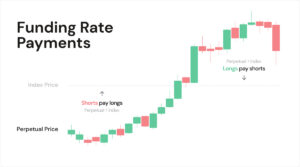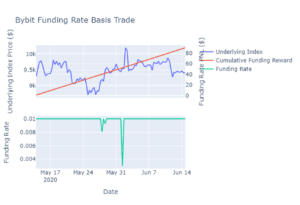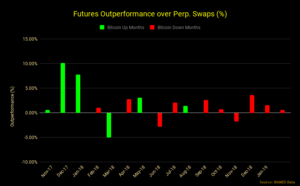Perpetual swaps are unique financial instruments that offer a way to trade on the future price of an asset without a fixed expiration date.
Think of it like betting on how much a cryptocurrency will be worth, with no set time limit for your prediction.
Unlike traditional Futures contracts, perpetual swaps never expire, allowing you to hold your position for as long as you want.
But a funding rate comes into play, like a small fee that gets exchanged between long and short positions.
This helps keep the price of perpetual swaps closely aligned with the asset’s spot price.
If you’re curious about venturing into the exciting world of perpetual swaps, this guide will be your launchpad.
We’ll delve into
- Details of these contracts
- Funding rate and
- The knowledge required to navigate this dynamic trading arena.
Understanding Perpetual Contracts: Unraveling the Basics of Futures Trading
Now that you’ve been introduced to perpetual swaps let’s delve deeper into the concept of perpetual Future contracts.
What are Perpetual Future Contracts?
Imagine a traditional Futures contract, an agreement to buy or sell the asset at a predetermined price on a predetermined date.
Imagine stripping away the expiration date, leaving you with an open-ended contract that lets you trade on the future price without a fixed deadline.
That’s essentially a perpetual Future contract!
Key Differences from Traditional Futures:
Here’s what sets perpetual Futures apart from their traditional counterparts:
- No Expiry Date: Unlike traditional Futures contracts with fixed expiries, perpetual Futures can be held without the complexity of expiration dates.
This flexibility allows you to hold your long or short position for as long as you believe the price will move in your favor. - Settlement in Margin: Instead of physically delivering or receiving the trading product, perpetual Futures are settled in the margin.
This means you only need to deposit a portion of the total contract value as collateral on the crypto derivative exchange, allowing you to control a larger position with less capital. - Leverage: Using margin allows for leverage, amplifying your potential profits and potential losses.
Remember, trading with leverage comes with increased risk, so it is crucial to use it responsibly and effectively manage your cryptocurrency trading risk exposure. - Funding Rate: Perpetual Futures employ a unique feature called the funding rate, which we’ll explore later.
This rate means the Futures price closely tracks the underlying asset’s price and prevents arbitrage opportunities.
Advantages and Disadvantages:
As with any financial instrument, perpetual Futures come with both advantages and disadvantages:
Advantages:
- Flexibility: Lack of an expiration date allows for long-term or short-term Futures trading strategies.
- Leverage: Amplifies potential gains in trading perpetual swaps.
- Liquidity: High trading volume ensures easy entry and exit as derivatives trading has become the most popular form of daily trading.
Disadvantages:
- Complexity: Requires understanding of how funding rate is calculated and risk management in the perpetual swap market.
- Volatility can lead to losses if not managed or if you don’t understand how the funding rate is applied.
- Regulation: The uncertain regulatory landscape in some regions might limit your exposure to the asset.
Understanding these key characteristics is crucial for anyone seeking to open a perpetual swap position.
You’ll be better equipped to make informed decisions and navigate this dynamic market effectively with a clear understanding of how these perpetual contracts work.
Funding Rate Explained: Keeping Perpetual Futures Swaps on Track
Now that you’ve grasped the basics of perpetual Future contracts, it’s time to dissect a crucial element that keeps them functioning smoothly: the funding rate.
Imagine this as the invisible force that helps maintain balance and prevent perpetual swaps from deviating too far from the underlying asset’s spot price.
What is the Funding Rate?
Think of the funding rate as a small fee exchanged between long and short traders every few hours.
This fee ensures that the price of the perpetual swap contract stays closely aligned with the actual price of the underlying asset.
How is it Calculated?
The exact calculation of the funding rate can be complex, but here’s a simplified explanation:
- Interest Rate: A base interest rate is applied based on the difference between the perpetual and underlying asset prices.
- Funding Premium/Discount: Longs pay a funding premium to shorts if the perpetual price exceeds the underlying asset price.
- This incentivizes shorts and discourages longs, bringing the perpetual price closer to the spot price of the underlying asset.
- Funding Discount/Premium: The opposite occurs if the perpetual price is lower than the underlying asset price.
- Shorts pay a funding premium to longs, encouraging longs and discouraging shorts, again bringing the prices closer to each other.
Positive and Negative Funding Rates: The Impact
- Positive Funding Rate: Longs pay shorts when the funding rate is positive. This indicates that there are more longs than shorts, which pushes the perpetual price slightly higher.
- Negative Funding Rate: Conversely, shorts pay for longs when the funding rate is negative. This suggests more shorts than longs, pulling the perpetual price slightly lower.
Strategies for Managing Funding Rate Risk:
Understanding the impact of the funding rate is crucial, as it can affect their profits and losses.
Here are some strategies to manage this risk:
- Consider the funding rate when entering and exiting positions.
- Use limit orders to control your entry and exit prices.
- Diversify your portfolio across different perpetual contracts.
- Close your positions before the funding rate is paid if the rate is unfavorable.
Example of Calculating Funding Rate:
The perpetual swap price to sell a Bitcoin perpetual contract is $20,000, and the underlying Bitcoin price is $19,800.
The base interest rate is 5% per year.
- Funding premium: 5% * ($20,000 – $19,800) = $100 per contract.
- Every 8 hours, long positions would pay $100 to short positions.
Understanding the funding rate and its impact is essential for someone looking to succeed in Bitcoin perpetual swap trading.
By actively managing this risk factor, you can confidently navigate the price of the perp and this type of derivative contract.
Strategies for Trading Perpetual Swaps: Navigating the Market with Confidence
Having grasped the fundamentals of perpetual swaps and the crucial role of the funding rate, we now delve into the exciting realm of trading strategies.
With a flexible and powerful instrument like perpetual swaps, various strategies can be employed to capitalize on market movements, each catering to different risk tolerances and timeframes.
Types of Perpetual Swap Trading Strategies:
- Long-Term Holding: For traders with a long-term perspective, holding onto long positions aligns with a belief in the underlying asset’s future price appreciation.
- This buy-and-hold strategy requires patience and a strong conviction in the asset’s potential, but it can be rewarding if the market trend aligns with their predictions and they keep their positions open.
- Short-Term Trading: This approach involves actively buying and selling a derivative contract that allows a shorter timeframe, aiming to profit from short-term price fluctuations in the crypto trading market.
- This can be achieved through various strategies, such as:
- Scalping: Exploiting crypto derivatives’ small, intraday price movements for quick profits.
- Day Trading: Entering and exiting positions within a single trading day, capitalizing on the trading direction and short-term opportunities.
- Hedging: Perpetual swaps can hedge existing cryptocurrency holdings in the spot market, mitigating potential losses in volatile derivate markets.
- By taking short positions on perpetual swaps corresponding to your long holdings, you can protect yourself against downward price movements.
Risk Management Strategies:
Risk management is paramount in perpetual swap trading, regardless of your chosen strategy.
Here are some essential strategies to safeguard your cash settlement in derivative markets:
- Stop-loss orders automatically sell your assets if the price falls to a specific level, limiting potential losses.
- Position sizing: Allocate only a portion of your capital to each trade, preventing excessive risk exposure.
- Risk diversification: To mitigate portfolio risk, spread your investments and trading venues across different perpetual swap contracts and asset classes.
Considering the Funding Rate:
As discussed, the funding rate is crucial in perpetual swap trading.
It is crucial to factor the funding rate into your strategy, especially for long-term Futures or Options positions, as the accumulated fees can significantly impact your overall returns.
Remember, there’s no single “best” strategy for everyone.
The ideal approach depends on your risk tolerance, investment goals, and available time.
Experiment with different strategies and find what works best for you.
You can keep the perpetual swaps working in your favor by employing a well-defined strategy, understanding the rate mechanism, and diligently managing risk.
This will help you navigate the dynamic cryptocurrency market and achieve your trading goals.
Choosing a Perpetual Swap Exchange: Finding Your Cryptocurrency Trading Home
Now that you’re familiar with the intricacies of perpetual swaps and the Futures market and grasp different trading strategies, it’s time to choose your battleground: the perpetual swap exchange.
The platform is crucial for a smooth and successful trading experience, like finding the perfect home base for your adventures.
Factors to Consider:
Several key factors should influence you when choosing a perpetual swap exchange:
- Security and Reliability: Prioritize platforms with a strong track record of security, including robust security measures like two-factor authentication (2FA) and cold storage for user funds.
- Liquidity and Trading Volume: High liquidity ensures easy entry and exit from your positions, while significant trading volume indicates a healthy and active market, ensuring you get your contracts’ worth.
- Fees and Commissions: Compare the trading fees and commission structures of different crypto futures platforms.
- Consider both maker and taker fees and any potential withdrawal fees, as this will affect the asset values for cash settlement.
- Supported Cryptocurrencies: Ensure the exchange offers the specific cryptocurrencies you want to trade in the Futures and Options markets.
- User Interface and Features: Choose a platform with a user-friendly interface and clear navigation, especially if you’re a beginner and don’t completely understand how derivatives work.
- Consider additional features like advanced order types and margin trading (if you’re comfortable with the increased risk).
Popular Perpetual Swap Exchanges:
Several reputable exchanges offer perpetual swap and decentralized perpetual trading, each with unique strengths and weaknesses.
Here are some popular options:
- Binance: A leading exchange with high liquidity, a vast selection of cryptocurrencies, and an intuitive interface.
- BitMEX: A long-established exchange with a strong focus on perpetual swaps and a dedicated trading community.
- Bybit: A user-friendly platform with high-leverage options and various margin trading features.
- Kraken: A reliable exchange is known for its security, transparency, and focus on fiat-to-crypto trading.
Recommendations:
- Start with a well-established and reputable exchange.
- Consider your trading experience and risk tolerance when evaluating features.
- Research user reviews and compare different platforms before making your decision.
- Start with small amounts and gradually increase your trading activity as you gain experience.
Choosing the right perpetual swap exchange is essential in your trading journey.
Conclusion: Opening a Perpetual Swap Position with Confidence
Congratulations! You’ve reached the end of this comprehensive guide to perpetual swaps.
You’re now equipped with the essential knowledge to launch your exciting trading journey.
Remember, unlike Futures contracts, perpetual swaps offer a powerful tool to capitalize on future price movements but also carry inherent risks.
Approach this market with a cautious and responsible mindset, manage your risk effectively, and always prioritize your financial security.
Continue learning, exploring different strategies, and adapting to market changes.
By constantly refining your skills and knowledge, you can confidently navigate the dynamic world of perpetual swaps and potentially achieve your trading goals.
So, start your perpetual swap adventure, explore the possibilities, and trade with wisdom!




